Abstract
We consider a system of noncolliding Brownian motions introduced in our previous paper, in which the noncolliding condition is imposed in a finite time interval $(0,T]$. This is a temporally inhomogeneous diffusion process whose transition probability density depends on a value of $T$, and in the limit $T \to \infty$ it converges to a temporally homogeneous diffusion process called Dyson's model of Brownian motions. It is known that the distribution of particle positions in Dyson's model coincides with that of eigenvalues of a Hermitian matrix-valued process, whose entries are independent Brownian motions. In the present paper we construct such a Hermitian matrix-valued process, whose entries are sums of Brownian motions and Brownian bridges given independently of each other, that its eigenvalues are identically distributed with the particle positions of our temporally inhomogeneous system of noncolliding Brownian motions. As a corollary of this identification we derive the Harish-Chandra formula for an integral over the unitary group.
Citation
Makoto Katori. Hideki Tanemura. "Noncolliding Brownian motions and Harish-Chandra formula." Electron. Commun. Probab. 8 112 - 121, 2003. https://doi.org/10.1214/ECP.v8-1076
Information





